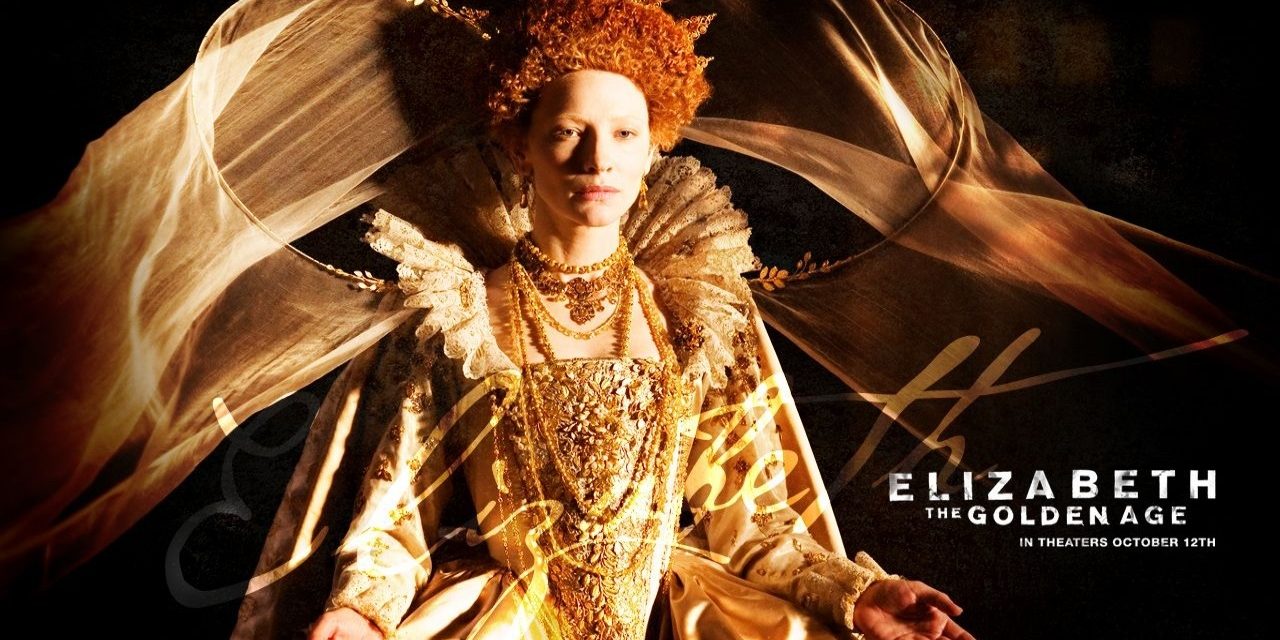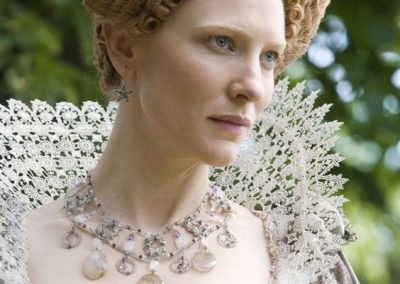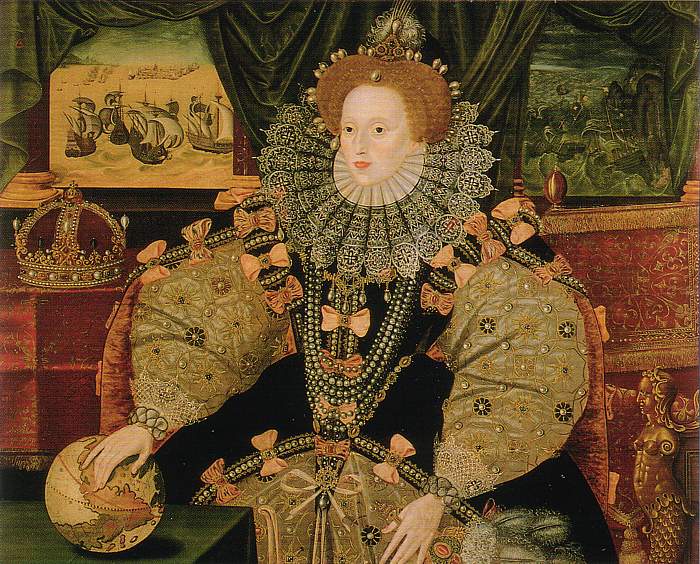Elizabeth: The Golden Age (2007)
Synopsis
A mature Queen Elizabeth endures multiple crises late in her reign including court intrigues, an assassination plot, the Spanish Armada, and romantic disappointments.
Directed by
Shekhar Kapur
Release date
12 October 2007 (USA)
Costume Designer
Alexandra Byrne
Studio
- Universal Pictures (presents)
- StudioCanal (in association with)
- Working Title Films (in association with)

Source: IMDB
Film trailer
About the Costume Design
Q
ueen Elizabeth I strongly influenced fashion over the course of her reign from 1558-1603. Before Elizabeth came to power in the mid-16th century, fashion in England was inspired by the Spanish and remained so up until the 1580s (Ashelford 12). Colors were somber and clothes had little embellishment (Ashelford 11). However by the 1560s, dress colors began to be much brighter with more decoration, and, as seen in Fig. 1, people began slashing the outer fabrics to expose contrasting colors in different layers (Ashelford 11). Ruffs, elaborately starched and ‘ruffled’ collars, were enormously popular among both men and women. By 1585, fashion historian Jane Ashelford notes “the ruff had reached its greatest extent and was balanced by the wide trunk sleeves, slender bodice and bell-shaped skirt” (12). Ruffs and collars came in many shapes and sizes, made of ruffled lace or gauzy linen that rose behind the head and dipped down in front of the bodice. The wideness of the collars helped balance out the silhouette, with its wide skirts and elongated torsos. A major component of the silhouette was an underskirt called the farthingale (originally from Spain), which helped set the shape of the skirt in an inflexible cone-shape (Ashelford 12). The farthingale is what helped Queen Elizabeth and the rest of English nobility maintain the distinctive shape of their dresses in the second half of the 16th century.
Costume designer for Elizabeth: The Golden Age, Alexandra Byrne, hews closely to the recognizable silhouette from the time period, emphasizing especially the dramatic ruffs and collars so widely attributed to Queen Elizabeth and the Elizabethan era, as seen in Figs. A and B. She even incorporates the famous butterfly-shaped collar (Fig. C) that is seen in some of the queen’s original portraits like the 1592 Ditchley portrait (Fig. 2). She reflects the typical silhouette of the dress by using two inverted triangles that meet at the waist (Fig. D). This gave off the sense of an elongated torso and allowed women to show off different fabrics in layers (Fig. 3).
Byrne chose to dress Cate Blanchett as the queen in rich, bright colors (Figs. E, F) that visually set her apart from the rest of the characters in the film. Being the most lavishly dressed figure reflects her status, power and the importance of her public image. In portraits of the queen such as Fig. 4, it is evident that her gowns were richly embroidered with colorful threads and jewels. However, Byrne’s costumes are more monochromatic in their fabric colors and embroidery (Fig. G). In another divergence from the historical reality, the film depicts Elizabeth wearing bright colors such as red, blue, yellow, or even green, while records suggest that the queen “adopted black and white as her personal colors” (Brown 97). Indeed, portraits of the queen feature dark colored fabrics, and sometimes white, attesting to this preference (Fig. 2). In the film (as in life) Elizabeth wore white (Fig. H) to emphasize her position as the “virgin queen,” married only to her country, but also to emphasize youthfulness and, again, wealth, since (like black), it was one of the most difficult colors to care for.
One fashion detail that Byrne chose to leave out was the practice of bombasting that was very popular in the second half of the 16th century. This was an essential practice in men and women’s fashion, where one would stuff one’s clothes with cotton, horsehair, wool, or even sawdust in order to obtain a more exaggerated shape of the body and clothes. It is common for costume designers to omit this trend in their artistic interpretations of 16th-century fashion in favor of a more streamlined appearance that is favored today. Byrne’s work in this film earned her an Academy Award in Costume Design in 2007.
Fig. 1 - Nicholas Hilliard (English, 1547-1619). The ‘Phoenix’ portrait, Queen Elizabeth I, ca. 1575. Oil on panel. London: National Portrait Gallery, NPG 190. Source: The Independent
Fig. 2 - Marcus Gheeraerts the Younger (Flemish, 1561-1636). Queen Elizabeth I ('The Ditchley portrait'), ca. 1592. Oil on canvas; 241.3 x 152.4 cm (95 x 60 in). London: National Portrait Gallery, NPG 2561. Source: Luminarium
Fig. 3 - Nicholas Hilliard (English, 1547-1619). The "Hardwick Hall" portrait of Elizabeth I of England, ca. 1599. Source: Wikipedia
Fig. 4 - Artist unknown (English). Queen Elizabeth I, ca. 1588. Oil on panel; 97.8 x 72.4 cm (38 1/2 x 28 1/2 in). London: National Portrait Gallery, NPG 541. Source: Art Net News
About the Costume Designer
A
lexandra Byrne (1962 – present) is an English costume designer who is best known for her costumes in historical dramas on screen (Wikipedia). Byrne’s interest in historical research and attention to detail is evident in the quality of work that goes into the costume sketches for this film, as seen in Fig. 5, which depicts the persimmon-colored gown Elizabeth wears in Fig. A. Her work in film includes Persuasion (1995), Hamlet (1996), Elizabeth (1998), Captain Corelli’s Mandolin (2001), Finding Neverland (2004), and The Phantom of the Opera (2004). She won an Oscar for her work on Elizabeth: The Golden Age (2007) and has earned four other Academy Award nominations for her costume design.
Since winning the Oscar, Byrne has also designed costumes for Marvel films, including Thor (2011), The Avengers (2012), Guardians of the Galaxy (2014), Avengers: Age of Ultron (2015), and Doctor Strange (2016).
Fig. 5 - David Downton (English, 1959-present). Publicity sketch of Elizabeth I for Elizabeth: The Golden Age, 2007. Source: Working Title Films
Fig. 6 - Cate Blanchett as Queen Elizabeth I. Promotional image. Source: Revealed in Time blog
References:
- “Alexandra Byrne.” Wikipedia, June 16, 2017. https://en.wikipedia.org/w/index.php?title=Alexandra_Byrne&oldid=785944788.
- Ashelford, Jane. Dress in the Age of Elizabeth I. London: Batsford, 1988. http://www.worldcat.org/oclc/17981612.
- Brown, Susan, ed. Fashion: The Definitive History of Costume and Style. New York: DK Publishing, 2012. http://www.worldcat.org/oclc/840417029.
Gallery credits:
- Fig. A – Working Title Films
- Fig. B – Pinterest
- Fig. C – Pinterest
- Fig. D – Pinterest
- Fig. E – Clothes to Midnight Blog
- Fig. F – Pinterest
- Fig. G – IMDB
- Fig. H – Pinterest
























